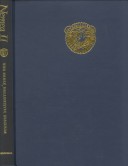Excavations at Nemea
1 primary work
Book 2
Since 1974, under the direction of Stephen G. Miller, the Classics Department of the University of California, Berkeley, has been excavating at Nemea, one of four sites in Greece of ancient athletic games and festivals. This second volume in the "Excavations at Nemea" series presents the Early Hellenistic stadium, used to celebrate the games from around 330 to 271 b.c. The presentation of remains includes findings on related structures - the entrance tunnel, with its ancient graffiti, and the Apodyterion, or undressing room, used by the athletes who competed - as well as on the track, the hydraulic system, the seating for judges and spectators, the starting line, the starting mechanism, and the turning post for foot races. All the structures and artifacts are set into the broader context of other contemporaneous stadia. The contributing authors provide insight into the Games at Nemea by analyzing the coins found at the site and relating them to the makeup of the crowds and by giving a human dimension to the Games by focusing on an inscription honoring the death of a Lydian there.
The architectural remains at Nemea give a 'stop action' picture of the stadium and the activities associated with it at the beginning of the Hellenistic era. They represent evidence of an entertainment industry that began to develop, in both theatrical performances and athletic contests, in the time of Alexander the Great - one that set apart professional performers from citizen spectators, a separation that also reflected changes in Hellenistic education and society.
The architectural remains at Nemea give a 'stop action' picture of the stadium and the activities associated with it at the beginning of the Hellenistic era. They represent evidence of an entertainment industry that began to develop, in both theatrical performances and athletic contests, in the time of Alexander the Great - one that set apart professional performers from citizen spectators, a separation that also reflected changes in Hellenistic education and society.
